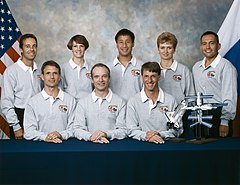STS-84
 | |
| Dane misji | |
| Indeks COSPAR | 1997-023A |
|---|---|
| Zaangażowani | |
| Oznaczenie kodowe | STS-84 |
| Pojazd | |
| Wahadłowiec | Atlantis |
| Załoga | |
 Od lewej: Jean-Francois Clervoy, Jerry Linenger, Eileen Collins, Charles Precourt, Edward Lu, Michael Foale, Jelena Kondakowa i Carlos Noriega. | |
| Dowódca | Charles Precourt |
| Start | |
| Miejsce startu | Stany Zjednoczone, KSC, LC39-A |
| Początek misji | 15 maja 1997 08:07:48 UTC[1] |
| Orbita okołoziemska | |
| Apogeum | 393 km |
| Perygeum | 377 km |
| Okres orbitalny | 92,3 min |
| Inklinacja orbity | 51,7° |
| Lądowanie | |
| Miejsce lądowania | KSC, Pas startowy 33 |
| Lądowanie | 24 maja 1997 13:27:44 UTC[1] |
| Czas trwania misji | 9 dni, 5 godz., 19 min, 56 sek[1] |
| Przebyta odległość | 6 mln km |
| Liczba okrążeń Ziemi | 145[2] |
| Program lotów wahadłowców | |
STS-84 (ang. Space Transportation System) – misja amerykańskiego wahadłowca Atlantis na rosyjską stacji kosmicznej Mir. Był to dziewiętnasty lot promu Atlantis i osiemdziesiąty czwarty programu lotów wahadłowców.
Załoga
- Charles Precourt (3)*, Dowódca (CDR)
- Eileen Collins (2), Pilot (PLT)
- Carlos Noriega (1), Specjalista misji (MS2)
- Edward Lu, (1), Specjalista misji (MS3)
- Jean-François Clervoy (2), (ESA) Specjalista misji (MS1) (Francja)
- Jelena Kondakowa (2), (RKA) Specjalista misji (MS4) (Rosja)
Przywieziony członek załogi Mira
- Michael Foale (4), Specjalista misji (MS5)
Odwieziony na Ziemię członek załogi Mira
- Jerry Linenger (2)
- *(liczba w nawiasie oznacza liczbę lotów odbytych przez każdego z astronautów)
Parametry misji
- Masa:
- Perygeum: 377 km[1]
- Apogeum: 393 km[1]
- Inklinacja: 51,7°[1]
- Okres orbitalny: 92,3 min[1]
Cel misji
Szósty lot wahadłowca na rosyjską stację Mir; na Ziemię powrócił (132 dni 4 godz. 1 min w kosmosie) astronauta Jerry Linenger (na stację przyleciał promem Atlantis w misji STS-81), którego miejsce zajął Michael Foale[4].
Dokowanie do Mira
- Połączenie z Mirem: 17 maja 1997, 02:33:20 UTC
- Odłączenie od Mira: 22 maja 1997, 01:03:56 UTC
- Łączny czas dokowania: 4 dni 22 godziny 30 minut 36 sekund
Zobacz też
Przypisy
- ↑ a b c d e f g h i Mark Wade: STS-84 (ang.). W: Encyclopedia Astronautica [on-line]. [dostęp 2017-07-25].
- ↑ a b podsumowanie misji STS-84 na stronie KSC (ang.)
- ↑ Robert Godwin: Space Shuttle. Warszawa: Wydawnictwo >DEBIT<, 2011, s. 77, seria: Historia podboju Kosmosu. ISBN 978-83-7648-973-5.
- ↑ a b Tomáš Přibyl: Dzień, w którym nie wróciła COLUMBIA. Bielsko-Biała: Wydawnictwo >DEBIT<, 2003, s. 172. ISBN 83-7167-224-1.
Linki zewnętrzne
- podsumowanie misji STS-84 na stronie KSC (ang.)
- Mark Wade: STS-84 (ang.). W: Encyclopedia Astronautica [on-line]. [dostęp 2017-07-25].
- Spaceflight mission report: STS-84 (ang.). Spacefacts. [dostęp 2017-07-25].
Media użyte na tej stronie
The flag of Navassa Island is simply the United States flag. It does not have a "local" flag or "unofficial" flag; it is an uninhabited island. The version with a profile view was based on Flags of the World and as a fictional design has no status warranting a place on any Wiki. It was made up by a random person with no connection to the island, it has never flown on the island, and it has never received any sort of recognition or validation by any authority. The person quoted on that page has no authority to bestow a flag, "unofficial" or otherwise, on the island.
The crew assigned to the STS-84 mission included (seated front left to right) Jerry M Linenger, mission specialist; Charles J. Precourt, commander; and C. Michael Foale, mission specialist. On the back row (left to right) are Jean-Francois Clervoy (ESA), mission specialist; Eileen M. Collins, pilot; Edward T. Lu, mission specialist; Elena V. Kondakova (RSA), mission specialist; and Carlos I. Noriega, mission specialist. Launched aboard the Space Shuttle Atlantis on May 15, 1997 at 4:07:48 am (EDT), the STS-84 mission served as the sixth U.S. Space Shuttle-Russian Space Station Mir docking.
The official NASA patch for the Shuttle-Mir Program, showing a Space Shuttle Orbiter docked to the Russian Space Station Mir, flying above a stylised Earth. The patch is bordered by the colours of the flags of Russia and the USA
The STS-84 emblem depicts the Space Shuttle Atlantis launching into Earth orbit to join the Russian Space Station Mir as part of Phase One (Shuttle-Mir) of the International Space Station program. The names of the eight astronauts who flew onboard Atlantis, including the two who changed their positions onboard Mir for a long duration flight, are shown along the border of the patch. The STS-84/Mir-23 team will transfer 7,000 pounds of experiments, Station hardware, food and clothing to and from Mir during the five-day period of docking. The Phase One program is represented by the rising Sun and by the Greek letter Phi followed by one star. This sixth Shuttle-Mir docking mission is symbolized by the six stars surrounding the word Mir in Cyrillic characters. Combined, the seven stars symbolize the current configuration of Mir, composed of six modules launched by the Russians and one module brought up by Atlantis on a previous docking flight.




